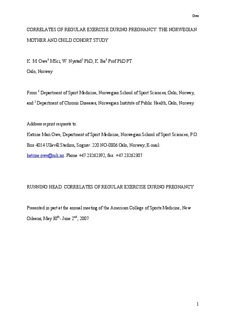| dc.contributor.author | Owe, Katrine M. | |
| dc.contributor.author | Nystad, Wenche | |
| dc.contributor.author | Bø, Kari | |
| dc.date.accessioned | 2010-04-30T09:14:08Z | |
| dc.date.available | 2010-04-30T09:14:08Z | |
| dc.date.issued | 2008-07-08 | |
| dc.identifier | Seksjon for idrettsmedisinske fag / Department of Sports Medicine | |
| dc.identifier.citation | Scandinavian Journal of Medicine & Science in Sports. 2009, 19(5), 637-645 | en_US |
| dc.identifier.issn | 0905-7188 | |
| dc.identifier.uri | http://hdl.handle.net/11250/170611 | |
| dc.description | I Brage finner du siste tekst-versjon av artikkelen, og den kan inneholde ubetydelige forskjeller fra forlagets pdf-versjon. Forlagets pdf-versjon finner du på www.wiley.com: http://dx.doi.org/10.1111/j.1600-0838.2008.00840.x / In Brage you'll find the final text version of the article, and it may contain insignificant differences from the journal's pdf version. The definitive version is available at www.wiley.com: http://dx.doi.org/10.1111/j.1600-0838.2008.00840.x | en_US |
| dc.description.abstract | The aims of this study were to describe the level of exercise during pregnancy and to assess factors associated with regular exercise. Using data from the Norwegian Mother and Child Cohort Study conducted by the Norwegian Institute of Public Health, 34 508 pregnancies were included in the present study. Data were collected by self-completed questionnaires in gestational weeks 17 and 30, and analyzed by logistic regression analysis. The results are presented as adjusted odds ratios (aOR) with a 95% confidence interval. The proportion of women exercising regularly was 46.4% before pregnancy and decreased to 28.0 and 20.4% in weeks 17 and 30, respectively. Walking and bicycling were the most frequently reported activities before and during pregnancy. The prevalence of swimming tended to increase from prepregnancy to week 30. Exercising regularly prepregnancy was highly related to regular exercise in week 17, aOR=18.4 (17.1–19.7) and 30, aOR 4.3 (4.1–4.6). Low gestational weight gain was positively associated with regular exercise in week 30, aOR=1.2 (1.1–1.4), whereas being overweight before pregnancy was inversely associated with regular exercise in week 17, aOR=0.8 (0.7–0.8) and 30, aOR=0.7 (0.6–0.7). Also, women experiencing a multiple pregnancy, pelvic girdle pain, or nausea were less likely to exercise regularly. | en_US |
| dc.language.iso | eng | en_US |
| dc.publisher | Wiley | en_US |
| dc.subject | prospective | en_US |
| dc.subject | population-based | en_US |
| dc.subject | recreational exercise | en_US |
| dc.subject | pregnancy | en_US |
| dc.subject | correlates | en_US |
| dc.title | Correlates of regular exercise during pregnancy: the Norwegian Mother and Child Cohort Study | en_US |
| dc.type | Journal article | en_US |
| dc.type | Peer reviewed | en_US |
| dc.subject.nsi | VDP::Social science: 200::Social science in sports: 330::Other subjects within physical education: 339 | en_US |
| dc.source.pagenumber | 637-645 | |
